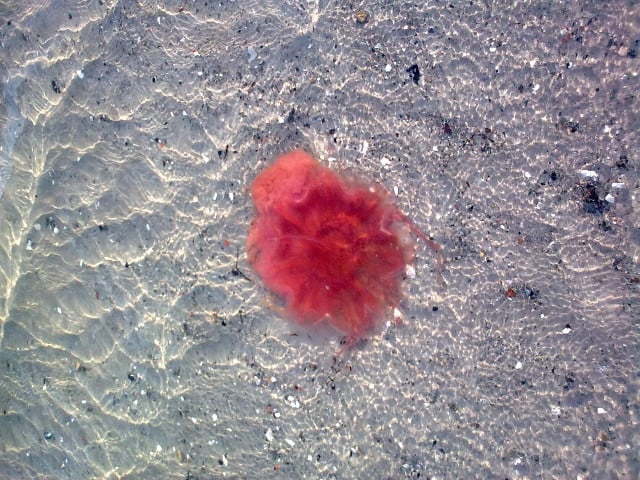
Jellyfish stings can not only be painful, but in the case of certain species of jellyfish they can also be life-threatening. Find out what to do if you get stung by a jellyfish here.
Most species of jellyfish are harmless to humans. They do not hunt for prey, but collect their food as they move through the ocean. Some jellyfish, however, also hunt fish. These have stinging capsules on their tentacles that contain a poison. The poison is attached to a thread in the stinging capsule in a kind of poison harpoon. If the stinging capsule bursts, the poison harpoon is launched.
If you touch a poisonous jellyfish in the sea or accidentally step on it, the poisonous harpoon will easily penetrate your skin. This can happen even with a light touch. A jellyfish sting is primarily a stinging pain. However, it can also be completely painless.
Jellyfish sting: These symptoms occur

(Photo: CC0 / Pixabay / wal_172619)
In addition to the pain, you can recognize a jellyfish sting by the following signs:
- skin rash
- Redness
- Swelling of the skin
- itching
- Hives
- rough skin
- slight discoloration
- Pustules
These symptoms usually appear immediately after the jellyfish sting. In the case of harmless stings, the symptoms disappear on their own after about ten days.
Complications occur especially if you are allergic to the poison. This can trigger an anaphylactic shock. If you experience dizziness or shortness of breath after a jellyfish sting, you should call the emergency services immediately.
If you have a jellyfish sting on your face or genitals, you should seek medical advice immediately.
Immediately after the jellyfish sting: first measures

(Photo: CC0 / Pixabay / Sumse)
If you have been stung by a jellyfish, the first thing to do is to stay calm. Then follow these tips:
- Get out of the water and ask your fellow people for help.
- Be careful not to move too quickly or too much. This will prevent the poison from spreading more quickly in your body.
- If there are still tentacles in the skin, wash them off with sea water. Drinking water is not suitable for this, as this could activate even more stinging cells.
- If tentacles do not come off with water, use tweezers or a credit card to remove them. Never use your fingers!
- Do not bandage the affected area, but allow as much air as possible to reach the stitch.
- If no worrying symptoms occur, such as circulatory or respiratory problems or physical weakness, it is usually not necessary to go to hospital. However, if in doubt, it is always advisable to seek medical advice.
Note: Many species of jellyfish live in tropical and subtropical areas in particular and release poisons that are life-threatening to humans. If you are stung by a jellyfish in these areas, you should be particularly vigilant and seek immediate treatment in a hospital. If the poison is actually life-threatening, antidotes are often available.
Home remedies for jellyfish stings?
Avoid using home remedies to treat a jellyfish sting. Internet portals recommend using urine, vinegar or baking soda, for example. However, there is no scientific evidence that these remedies are effective. In addition, they can even be harmful to some species of jellyfish and cause them to release even more poison.
If a jellyfish sting is not a problem and you just want to relieve itching, redness and swelling, you can ask a dermatologist to prescribe appropriate creams and ointments. Otherwise, the sting usually heals on its own.
A jellyfish sting can also have long-term effects. These include slight discoloration or loss of sensation in the skin, which can persist even months later. Scars can also form on the affected area after a jellyfish sting.
Read more on Techzle\.com:
- “Squalling” of the seas: Not only stings are increasing
- Poisonous weever fish sting: First aid in case of contact with the fish
- Tick bite symptoms: What to do if the bite itches and is red
** marked with ** or orange underlined Links to sources are partly affiliate links: If you buy here, you are actively supporting Techzle\.com, because we then receive a small part of the sales proceeds. .